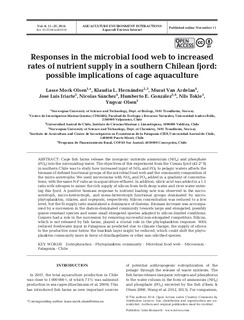| dc.contributor.author | Olsen, Lasse Mork | |
| dc.contributor.author | Hernandez, Klaudia | |
| dc.contributor.author | Ardelan, Murat Van | |
| dc.contributor.author | Iriarte, Jose Luis | |
| dc.contributor.author | Sanchez, Nicolas | |
| dc.contributor.author | Gonzalez, Humberto E. | |
| dc.contributor.author | Tokle, Nils Egil | |
| dc.contributor.author | Olsen, Yngvar | |
| dc.date.accessioned | 2017-10-02T09:07:56Z | |
| dc.date.available | 2017-10-02T09:07:56Z | |
| dc.date.created | 2014-11-14T12:12:58Z | |
| dc.date.issued | 2014 | |
| dc.identifier.citation | Aquaculture Environment Interactions. 2014, 6 (1), 11-27. | nb_NO |
| dc.identifier.issn | 1869-215X | |
| dc.identifier.uri | http://hdl.handle.net/11250/2457652 | |
| dc.description.abstract | ABSTRACT: Cage fish farms release the inorganic nutrients ammonium (NH4) and phosphate (PO4) into the surrounding water. The objectives of this experiment from the Comau fjord (42.2° S) in southern Chile was to study how increased input of NH4 and PO4 to pelagic waters affects the biomass of defined functional groups of the microbial food web and the community composition of the micro-autotrophs. We used microcosms with NH4 and PO4 added in a gradient of concentrations, with the same N:P ratio as in aquaculture effluent. In addition, silicic acid was added in a 1:1 ratio with nitrogen to mimic the rich supply of silicon from both deep water and river water entering this fjord. A positive biomass response to nutrient loading rate was observed in the microautotroph, micro-heterotroph, and meso-heterotroph functional groups dominated by microphytoplankton, ciliates, and copepods, respectively. Silicon concentration was reduced to a low level, but the Si supply ratio maintained a dominance of diatoms. Biomass increase was accompanied by a succession in the diatom-dominated community towards large and elongated, possibly grazer-resistant species and some small elongated species adapted to silicon-limited conditions. Grazers had a role in the succession by removing successful non-elongated competitors. Silicon, which is not released by fish farms, played a crucial role in the phytoplankton response. With reduced freshwater input in Patagonia as predicted due to climate change, the supply of silicon to the productive zone below the brackish layer might be reduced, which could shift the phytoplankton community more in favor of dinoflagellates or other non-silicified species. | nb_NO |
| dc.language.iso | eng | nb_NO |
| dc.publisher | Inter Research | nb_NO |
| dc.rights | Navngivelse 4.0 Internasjonal | * |
| dc.rights.uri | http://creativecommons.org/licenses/by/4.0/deed.no | * |
| dc.title | Responses in the microbial food web to increased rates of nutrient supply in a southern Chilean fjord: Possible implications of cage aquaculture | nb_NO |
| dc.type | Journal article | nb_NO |
| dc.type | Peer reviewed | nb_NO |
| dc.description.version | publishedVersion | nb_NO |
| dc.source.pagenumber | 11-27 | nb_NO |
| dc.source.volume | 6 | nb_NO |
| dc.source.journal | Aquaculture Environment Interactions | nb_NO |
| dc.source.issue | 1 | nb_NO |
| dc.identifier.doi | 10.3354/aei00114 | |
| dc.identifier.cristin | 1172885 | |
| dc.relation.project | Norges forskningsråd: 216607 | nb_NO |
| dc.description.localcode | © 2014 The Authors. Published by Inter Research. This is an open access article under the CC BY license (http://creativecommons.org/licenses/by/4.0/) | nb_NO |
| cristin.unitcode | 194,66,10,0 | |
| cristin.unitcode | 194,66,25,0 | |
| cristin.unitname | Institutt for biologi | |
| cristin.unitname | Institutt for kjemi | |
| cristin.ispublished | true | |
| cristin.fulltext | original | |
| cristin.qualitycode | 1 | |

